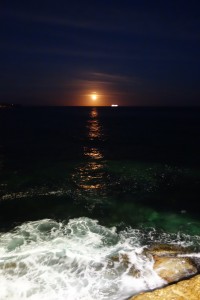2016年AAIR Forum に参加しました。(English ver.)
![]()
Participation in the 2016 AAIR Forum
Nov. 14-16, 2016, Coogee (Sydney, Australia)
Rintaro Ohno



A sunny sky. A clear blue ocean. A white beach. Warm summery temperatures you do not have in Japan during November. And me, sitting in a room without windows listening to talks about … whatever. Well, when I say “white beach”, I mean a massive crowd of annoying youngsters in short pants and sunburn … so its most likely not enjoyable anyway. (Of course there is no envy of any sorts involved whatsoever.)
This year’s AAIR Forum (the official lengthy term being: Australasian Association of Institutional Research Forum) was held in Sydney. Particularly in an area called Coogee, which is close, or to be more precise ON the beach and a total Resort area. Wearing a tie here is probably similar to a teenager being at an over-30’s-party … but I digress. Although most of the talks were concerned with topics about the local situation at universities in Australia and New Zealand, many were addressing the current direction of Institutional Research and important aspects of universities in general.
For example, in additio n to the well-known SES (Student Experience Survey) – probably something done at universities all over the world – the GOS (Graduate Outcome Survey) and ESS (Employer Satisfaction Survey) were newly introduced. The former deals with the general assessment of graduate’s experience at the university and the latter asks the current supervisor of said graduate how satisfied he or she is with the knowledge and skillset of the new guy fresh out of school. These are important and interesting things where universities could learn a lot from, but certainly have to be analyzed in more detail. Another development regarding the established SES is a new approach via early feedback, where students are asked their opinion about a course very early in the semester, so the lecturers have the opportunity to adjust accordingly. The only aspect, which seemed very unusual from a Japanese point of view was the obsession about the response rate. Sure, if you do a survey, you want to have as many answers as possible, but you could achieve that by simply using the time in class and handing students the questionnaire directly in person. Baiting them to give answers by rewards and other stuff seemed… off? But anyway, different countries, different customs.
Regarding general trends in Institutional Research, there were many talks criticizing the shift to newer technologies without understanding the ramifications or thinking about the details of what has been analyzed. Beautiful graphics and real time updates may be appealing on paper, but are useless if the “results” are left without proper thoughts. The Keynote Speaker, the Panel Session and many other talks were stressing the fact, that technology which only looks efficient but has no real purpose is basically a waste. And to quote said Keynote Speaker Paul Ormonde-James “A fool with a tool is still a fool”. (Although as a Mathematica enthusiast, I could not really agree with his other favorite expression “R is right”.)
The important fact is whether people are aware of the objective and have a proper roadmap to achieve it. If the correct decisions are made using the correct data, the technology used may still be a few years older – which is irrelevant. Too much data on the other side is not only a security risk, but also leads to confusion since not everybody is able to read or interpret it correctly. It seemed to be the consensus at the Forum, that the approach may differ, but the “Why?” should be clear to everybody in the organization and that analysts should tailor their presentations according to the person reading the report.
The atmosphere at the Forum was very friendly and although many attendees were actually competing with each other, nobody was shy to share their knowledge, experience and information. There were also a couple of very interesting discussions about the general purpose and raison d’être of universities, but it could not really top the Holy Stick of the indigenous people (I do apologize for not knowing the correct term) and the Super Moon at the Forum Dinner. (Ok, I did not catch the “super” part, since it seemed to be the same size as usual, but it was still one of the most impressive things I have seen in years.)
The AAIR Forum next year (or “this year” or “2017”, depending on when you are reading this) will be held in Alice Springs in early November and will probably have more detailed results regarding the GOS and ESS and will probably discuss the effects of even further developed technology. Anyway, it will most likely be very interesting to listen to the talks and join the discussion again.











